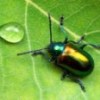
Lasius (Acanthomyops) arizonicus with mealybug, Huachuca Mountains, Arizona.
Students of the North American myrmecofauna will undoubtedly recognize this ant. Pudgy, pleasingly orange in color, and smelling sweetly of citrus, the Citronella ant is an endearing creature.  This Nearctic endemic is among our most common ants, living in underground empires farming root aphids and mealybugs for sustenance.
Yet few people ever encounter these shy insects. They emerge above ground for only a few hours each year, in late summer to see off the colony's winged reproductives.
The dozen or so citronella ant species have been placed historically in the genus Acanthomyops, a tightly-defined group marked by a number of recognizable morphological traits. This arrangement is no longer viable. Taxonomists had long suspected that Acanthomyops was a daughter lineage descended from the widespread Holarctic Lasius. Their suspicion has been confirmed by molecular genetic data from multiple studies, and Ward (2005) performed the inevitable demotion. Acanthomyops is now a subgenus of Lasius.

Carrying the mealybug to safety.
photo details: Canon MP-E 65mm 1-5x macro lens on a Canon EOS 20D
ISO 100, 1/250 sec, f/13, flash diffused through tracing paper

what part of the mealybug do they eat?
The Citronella ants here in New Jersey mostly fly in late fall.
Endearing, yes...
But to be respected. Seeing the many acute teeth on this worker's mandibles, I suspect her bite must be quite painful. Even the distant relative Lasius flavus inflicts a surprisingly aching one, given its fairly small size, especially when getting at the basis of the fingers and spraying formic acid inside the wound.
BTW, I think some of the "Citronella Ants" don't smell citronella at all. But maybe this results from confusions with other yellow Laisus?
While Acanthomyops queens have a quite distinctive, somewhat Myrmicine-like outline, workers are sometimes difficult to tell apart from workers of the umbratus group ( the so-called subgenus "Chtonolaisius")
Aydin -- The ants do not actually eat the hemipterans, but rather, their sugary waste product known as honeydew. They have an excess of sugar in their plant sap diet, and a specialized mechanism for excreting this while concentrating other nutrients.
MrILTA -- Different species fly at different times of the summer. Merl Wing's revision of the (sub-)genus, complete with detailed flight records, is accessible here http://osuc.biosci.ohio-state.edu/hymenoptera/manage_lit.list_pubs?auth…
Richard -- I recognize your name from bugguide. This isn't my blog, but one I frequent, so good to see you drop in. Anyway, in fact all the Acanthomyops do in fact have citronellol in their mandibular gland secretions, so I would second your guess about confusion with other Lasius. Some of those other yellow ones are quite shiny and have reduced, though not completely lost, terminal maxillary palp segments.
Thanks for the info, James.
The bad news is that "we" have at least a couple of Laisus workers misidentified as Acanthomyops in bugguide. But at least now, I know.
Endearing, perhaps only for their color... would anyone be able to tell me how I could get them out of my garden?
-Sarah
New Jersey